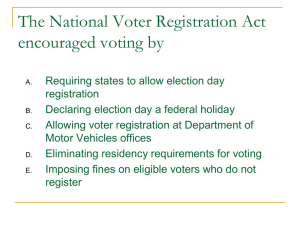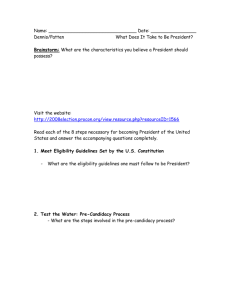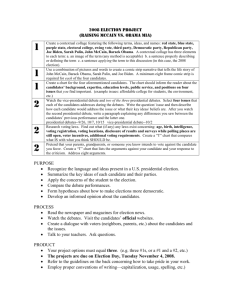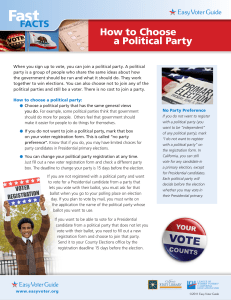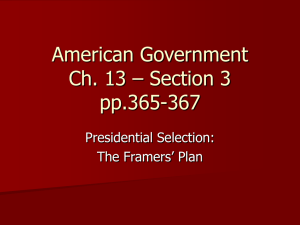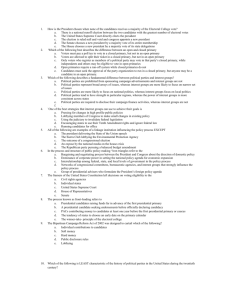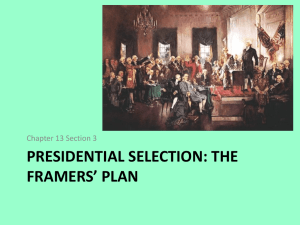CHAPTER 9: CAMPAIGNS AND VOTING BEHAVIOR Multiple
advertisement
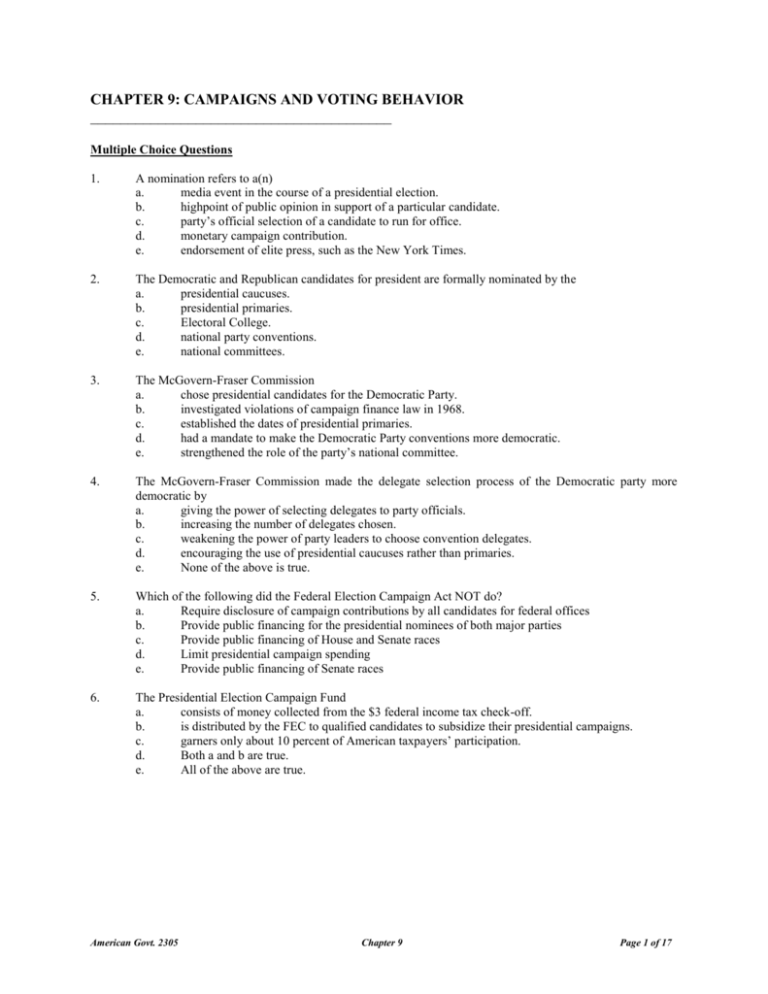
CHAPTER 9: CAMPAIGNS AND VOTING BEHAVIOR ________________________________________ Multiple Choice Questions 1. A nomination refers to a(n) a. media event in the course of a presidential election. b. highpoint of public opinion in support of a particular candidate. c. party’s official selection of a candidate to run for office. d. monetary campaign contribution. e. endorsement of elite press, such as the New York Times. 2. The Democratic and Republican candidates for president are formally nominated by the a. presidential caucuses. b. presidential primaries. c. Electoral College. d. national party conventions. e. national committees. 3. The McGovern-Fraser Commission a. chose presidential candidates for the Democratic Party. b. investigated violations of campaign finance law in 1968. c. established the dates of presidential primaries. d. had a mandate to make the Democratic Party conventions more democratic. e. strengthened the role of the party’s national committee. 4. The McGovern-Fraser Commission made the delegate selection process of the Democratic party more democratic by a. giving the power of selecting delegates to party officials. b. increasing the number of delegates chosen. c. weakening the power of party leaders to choose convention delegates. d. encouraging the use of presidential caucuses rather than primaries. e. None of the above is true. 5. Which of the following did the Federal Election Campaign Act NOT do? a. Require disclosure of campaign contributions by all candidates for federal offices b. Provide public financing for the presidential nominees of both major parties c. Provide public financing of House and Senate races d. Limit presidential campaign spending e. Provide public financing of Senate races 6. The Presidential Election Campaign Fund a. consists of money collected from the $3 federal income tax check-off. b. is distributed by the FEC to qualified candidates to subsidize their presidential campaigns. c. garners only about 10 percent of American taxpayers’ participation. d. Both a and b are true. e. All of the above are true. American Govt. 2305 Chapter 9 Page 1 of 17 7. Which of these is NOT one of the provisions of the McCain-Feingold Act? a. The subjecting of 527 groups to contribution restrictions b. The banning of soft-money contributions c. The increase in the amount that individuals can give to candidates, to rise with inflation d. The barring of groups from running “issue ads” within 60 days of an election if they refer to a federal candidate and are not funded through a PAC e. The prohibition of corporations’ and unions’ use of general treasury funds to pay for electioneering communications in the last 60 days of an election 8. The McCain-Feingold Act of 2002 a. increased the limit on individual contributions to presidential and congressional $2,000. b. decreased the limit on individual contributions to presidential and congressional $1,000. c. increased the limit on individual contributions to presidential and congressional $3,000. d. decreased the limit on individual contributions to presidential and congressional $3,000. e. banned individual contributions to presidential and congressional candidates. candidates to candidates to candidates to candidates to 9. The phenomenon that people’s beliefs often guide what they pay attention to and how they interpret events, common among voters in political campaigns, is a. selective perception. b. gate keeping. c. scorekeeping. d. agenda setting. e. frontloading. 10. Which of the following is an example of a 527 group? a. MoveOn.org b. JohnKerry.com c. The Republican Party of Iowa d. The Democratic Party of New Hampshire e. EggPac 11. Which of the following statements regarding political campaigns is FALSE? a. Most people pay relatively little attention to campaigns. b. Party identification influences voting behavior regardless of what happens in campaigns. c. Incumbents start with a substantial advantage in terms of name recognition and an established track record. d. Campaigns never change voters’ minds. e. In tight races, a good campaign can make the difference between winning and losing. 12. Researchers suggest that campaigns have three effects on voters; these are the following: a. reinforcement, activation, and conversion. b. reinforcement, gate keeping, and scorekeeping. c. selective perception, gate keeping, and conversion. d. agenda setting, gate keeping, and conversion. e. activation, selective perception, and reconversion. 13. Suffrage refers to a. a type of election unique to the United States. b. the right to vote. c. a voter registration system. d. voter turnout rates. e. voting procedures in the Electoral College. American Govt. 2305 Chapter 9 Page 2 of 17 14. According to a 2008 Census Bureau survey, the most common response given by nonvoters for not voting in the 2008 election was that they a. could not find their polling place. b. could not take off time from work or school that day. c. forgot that it was Election Day. d. did not know who the candidates were. e. forgot to register in time for the election. 15. The greater one’s sense of political efficacy, the a. less likely one is to vote. b. more likely one is to vote. c. greater one’s chance of being defeated in an election. d. less likely one is to view the election process in the United States as legitimate. e. more likely one is to see differences between the parties. 16. People with higher than average education a. are no more and no less likely to vote than people of lower educational levels. b. are more likely to vote than people of lower educational levels. c. are somewhat less likely to vote than people of lower educational levels. d. are much less likely to vote than people of lower educational levels because they know it won’t do any good. e. are more likely to vote than high school dropouts but less likely to vote than those with high school diplomas. 17. A theory of voting according to which voters make their decisions based on their answer to the question “What have you done for me lately?” is called a. policy voting. b. the mandate theory of elections. c. retrospective voting. d. political efficacy. e. prospective voting. 18. The Electoral College was originally established in order to a. provide direct election of the president by the people, although its operation has had the opposite effect. b. merely certify the results of the people’s choice for president and vice president. c. give the nation’s elite, rather than the people directly, the power to choose the president and vice president. d. insure high voter turnouts in elections throughout the country. e. give legitimacy to the presidency, which was regarded suspiciously by most people as another potential monarchy. 19. The greater the policy differences between the candidates, a. the less likely voters will be able to steer government policies by their choices. b. the more likely voters will be able to steer government policies by their choices. c. the less likely voters will turn out on Election Day. d. the more likely voters will provide an “echo” rather than a “voice” on Election Day. e. the more likely citizens will feel a sense of civic duty. True/False Questions 1. Superdelegates are the supreme power within each of the parties. 2. A meeting of all state party leaders for selecting delegates to the national party convention is called a primary. American Govt. 2305 Chapter 9 Page 3 of 17 3. Primaries emerged through reform efforts that sought to take nominations out of the hands of party bosses. 4. One result of modern campaigns is that a disproportionate amount of attention is given to caucuses and primaries occurring late in the calendar year. 5. The extended length of the nomination process advantages individuals who already hold prominent political positions. 6. Network news coverage of national political conventions has surged in recent decades. 7. The Federal Election Campaign Act of 1974 provided public financing for presidential primaries and general elections, limited presidential campaign spending, required disclosure, and attempted to limit contributions. 8. The significance of the Supreme Court decision in Buckley v. Valeo is that it upheld restrictions on the amount of money an individual could contribute to his or her own campaign. 9. “Soft money” refers to political contributions that are earmarked for party building activities. 10. The Republican Party is a form of PAC. 11. The phenomenon that people often pay the most attention to things that they already agree with is called selective perception. 12. According to Anthony Downs, rational people vote when they perceive meaningful policy differences between the candidates. 13. Voter turnout in state and national elections increased significantly after Congress passed the Motor Voter Act of 1993. 14. Older Americans are more likely to vote than are younger Americans. 15. The most widely accepted theory of voting behavior among political scientists is the mandate theory of elections. 16. It is possible for the Electoral College to choose a president who did not win a majority of the popular vote. 17. The greater the policy differences between the candidates, the more likely voters will be able to steer government policies by their choices. Multiple Choice Questions 1. A(n) ________ is a party’s official selection of a candidate to run for office. a. appointment b. nomination c. conversion d. imprimatur e. endorsement 2. The way in which candidates attempt to manipulate money, the media, and momentum to achieve the nomination is through a. campaign strategy. b. primaries. c. charisma. d. propaganda. e. party support. American Govt. 2305 Chapter 9 Page 4 of 17 3. In most advanced industrialized countries, election campaigns a. are endless affairs, sometimes lasting a year or more. b. are not limited by law. c. last more than two weeks by law or custom. d. last no more than two months by law or custom. e. are limited by law to three months. 4. The specific goal of the presidential nomination game is to win a majority of votes a. cast in presidential primaries. b. cast in presidential caucuses. c. among party delegates in order to win the party nomination. d. in the Electoral College. e. compared to the other party’s candidate in the general election. 5. The national party convention is a. the supreme power within each of the two parties. b. responsible for nominating the party’s presidential and vice presidential candidates. c. the author of the party’s national platform. d. All of these are true. e. None of these is true. 6. The intention of the McGovern-Fraser Commission reforms of the Democratic Party was to a. close delegate selection processes to the public. b. make national conventions more democratic. c. provide party leaders with more influence in national conventions. d. construct rules for media coverage of national conventions. e. grant the national convention the power to select party delegates. 7. The Democratic National Convention in ________ led to serious reforms, now referred to as the McGovern Fraser Commission reforms, in the methods it used to choose its convention delegates. a. 1936 b. 1968 c. 1952 d. 1984 e. 1992 8. Following the Democratic National Convention in Chicago in 1968, the party chose to a. limit attendance at future conventions to the elected officers of the party’s organizations nationwide. b. limit attendance at future conventions to the party’s nationwide elected government officeholders. c. tighten up its convention delegate selection to keep it from being overrun by women, minorities, youth, and single-issue groups. d. allow party officers and Democratic officeholders, many of whom had not been seated at recent conventions, to serve as “superdelegates.” e. open up its process of choosing delegates to the national convention in order to respond to demands for greater inclusion from women, minorities, youth, and other groups. National party leaders who automatically get a delegate slot at the national party convention are referred to as a. party bosses. b. McGovern-Fraser delegates. c. superdelegates. d. caucuses. e. frontloaders. 9. American Govt. 2305 Chapter 9 Page 5 of 17 10. In states with caucuses, a. supporters of candidates attend a series of open meetings to express presidential preferences. b. the state legislature selects the state’s delegates to the national conventions. c. party leaders select delegates according to their own candidate preferences. d. candidates appoint supporters to serve as delegates. e. delegates are chosen through the general election of a candidate. 11. The presidential primaries are a. elections in which voters in a state vote for a candidate or delegates pledged to the candidate. b. meetings of all state party leaders for selecting delegates to the national party convention. c. the supreme power within each of the parties, responsible for nominating the party’s presidential and vice presidential candidates. d. the official endorsement of a candidate for office by a political party. e. a master game plan through which candidates set out to guide their electoral campaign. 12. Today, a majority of the delegates to the national convention are selected through a. state party conventions. b. party caucuses. c. presidential primaries. d. local party conventions. e. state legislatures. 13. The addition of superdelegates to the Democratic national conventions was spearheaded by a. those who felt the Warren Commission had led to unrepresentative delegate selection. b. President Jimmy Carter. c. the McGovern-Fraser Commission. d. those who felt the McGovern-Fraser Commission had opened up the delegate selection process too much. e. the Warren Commission. 14. Historically, the presidential primary season begins in a. winter in New Hampshire. b. summer in New Hampshire. c. winter in Iowa. d. summer in Iowa. e. winter in Missouri. 15. The tendency of states to hold primaries earlier in the calendar to capitalize on media attention is called a. stacking the deck. b. frontloading. c. agenda setting. d. framing. e. politicking. 16. Frontloading refers to a. a strategy employed by candidate press secretaries that seeks to bombard the media with positive news. b. the recent tendency of states to hold primaries early in the calendar year in order to capitalize on media attention. c. a fundraising technique that candidates employ to amass large amounts of money before a campaign actually begins. d. bargaining among superdelegates over which candidate they will support at the national convention. e. candidates’ refusal to campaign in early primary states. American Govt. 2305 Chapter 9 Page 6 of 17 17. The state that has disproportionate power because it holds the first presidential primary each election year is a. New York. b. California. c. Iowa. d. New Hampshire. e. Rhode Island. 18. Voters in presidential primaries and caucuses tend to be a. very similar to the rest of the United States population in terms of education and income. b. older and more affluent than the United States population as a whole. c. minorities and notably younger than the general population. d. somewhat less educated and somewhat poorer on average than the United States population as a whole. e. far less educated and much poorer on average than the United States population as a whole. 19. In most caucus states, about ________ percent of the registered voters typically show up for party presidential caucuses. a. 5 b. 20 c. 35 d. 45 e. 50 20. Which of the following is NOT a major criticism of the primary and caucus system? a. Disproportionate attention goes to the early caucuses and primaries. b. Prominent politicians find it difficult to take time out of their duties to run. c. Money plays too big a role. d. Participation is low and unrepresentative. e. The system does not give enough power and access to the media. 21. Critics of primaries and caucuses contend that the new presidential “kingmakers” are now a. party bosses. b. the few who vote in the caucuses and primaries. c. the media. d. interest groups. e. state party organizations. 22. Network television news coverage of national party conventions has a. dramatically increased in response to the growing significance of national conventions in selecting presidential and vice presidential candidates. b. dramatically decreased in response to the declining significance of national conventions in selecting presidential and vice presidential candidates. c. experienced drastically larger audiences than news coverage of national party conventions in earlier decades. d. outpaced audience viewing of popular events, such as the Super Bowl. e. generally been limited to one major broadcast station, such as CBS or NBC. 23. The Federal Election Campaign Act a. provided public financing for Senate and House races. b. required broadcasters to provide free airtime to each major candidate for federal office. c. ended public financing for presidential campaigns. d. required all candidates for federal office to disclose all contributions made to their campaigns. e. removed spending limits from presidential campaigns. American Govt. 2305 Chapter 9 Page 7 of 17 24. The administration of campaign finance laws and the enforcement of compliance with their requirements is handled by the a. Fair Political Practices Commission. b. Campaign Finance Bureau of the Department of the Treasury. c. Department of Justice. d. Federal Election Commission. e. Government Accounting Office. 25. In Buckley v. Valeo (1976), the Supreme Court a. ruled that the wildly unequal campaign expenditures of candidates for government office were a violation of the equal protection clause of the Fourteenth Amendment and ordered Congress and the states to develop mechanisms to assure equal funding of all major candidates. b. limited the activities of political action committees. c. struck down the part of the Federal Election Campaign Act that restricted the amount individuals could contribute to their own campaign. d. stated that the Federal Election Commission had no power to enforce compliance with their requirements. e. declared the Federal Election Campaign Act unconstitutional. 26. Which of the following is permissible under current campaign finance regulations? a. Mitt Romney’s spending of $44 million out of his own pocket in pursuit of the Republican presidential nomination in 2008 b. A donation to candidate Barack Obama in 2010 in the amount of $10,000 from a single individual. c. An individual contribution to a congressional candidate in the amount of $5,000 in the 2008 elections. d. A soft-money contribution to a political party in the amount of $10,000 in the presidential election of 2000. e. None of these is permissible. 27. Contributions of up to $250 matched from the Presidential Election Campaign Fund to qualifying presidential nominees are called a. soft money. b. hard money. c. matching funds. d. tax cuts. e. illicit expenditures. 28. Soft money is a. money donated by a person to his or her own campaign. b. cash contributions that are not traceable and in some situations illegal. c. small donations that, while important to a campaign, are not as important as larger contributions. d. money loaned to a campaign but expected to be paid back. e. money donated to parties rather than to candidates; this type of contribution was declared illegal by the McCain-Feingold Act. 29. The appearance and increase in ________ was an unintended resulted of an amendment in 1979 to the original Campaign Reform Act, which allows parties to raise and spend money on voter registration and other campaign materials without limits on spending or the size of contributions that they can accept. a. party discretionary funding b. party expenditure exemption c. soft money d. expenditure waivers e. institutional assistance American Govt. 2305 Chapter 9 Page 8 of 17 30. One of the provisions of the McCain-Feingold Act of 2002 was to a. increase the limit on individual contributions to $5,000. b. increase the amount of federal money presidential candidates can spend. c. increase the limit on “soft money” contributions. d. increase the limit on individual contributions from $1,000 to $2,000. e. increase the limit on individual contributions to $10,000. 31. Which of the following is an example of a PAC? a. MoveOn.org b. Swift Boat Veterans for Truth c. The National Republican Party d. FishPAC e. All of these are examples of PACs. 32. The notion that candidates need to raise and spend enough money to compete but that it is not always necessary to outspend an opponent is called the a. majority-minority doctrine. b. doctrine of sufficiency. c. soft-money approach. d. selective perception. e. hydraulic theory of money and politics. 33. Suffrage means a. the legal right to vote. b. turning out to vote. c. voting for the winner. d. voting for the loser. e. the struggle for equal rights for women. 34. The belief that in order to support democratic government a citizen should always vote is a belief in the notion of a. civic duty. b. political efficacy. c. political legitimacy. d. suffrage. e. the mandate theory of elections. 35. Which of the following is NOT a factor that increases a person’s likelihood of voting? a. Having a sense of civic duty b. Possessing political efficacy c. Discerning the ways in which policy differences affect one’s interests d. Believing that some policies of one party are balanced by other policies of the other party e. Believing that the benefits of voting outweigh the costs 36. Anthony Downs’ theory of rational voting behavior predicts that people will vote if they a. can afford the time and energy to do so. b. think one party will give them more policy benefits than the other. c. think their vote will make the difference for a particular candidate. d. identify with a particular candidate, even though they doubt that one vote can make a difference. e. feel obligated to do so. American Govt. 2305 Chapter 9 Page 9 of 17 37. If you believe that “public officials don’t care much about what people like me think,” then you are expressing feelings of a. high political efficacy. b. low political efficacy. c. rationality. d. policy voting. e. retrospective voting. 38. Largely to prevent corruption associated with stuffing ballot boxes, states adopted ________ around the turn of the twentieth century. a. the Electoral College b. primary elections c. voting machines d. voter registration e. the secret ballot 39. A major reason cited for America’s level of voter turnout compared to other industrialized countries is a. bad weather in certain parts of the United States on Election Day. b. greater interest in democracy in the United States. c. registration is more cumbersome in the United States. d. registration is more cumbersome in other nations. e. Americans’ high sense of political efficacy. 40. Highly educated individuals are more likely to vote because they a. are smarter. b. can better discern policy differences between candidates. c. have a lower sense of political efficacy. d. are usually white males. e. have more influence in the political process. 41. Which of the following statements about voter turnout in the U.S. is FALSE? a. Older people are less likely than younger people to vote. b. People with higher than average education levels have a higher voter participation rate. c. African Americans are less likely than whites to vote. d. Americans’ voter participation rate is far lower than voter turnout in other democracies. e. Women are more likely to vote than men. 42. Just over ____ of the population votes. a. one-quarter b. one-third c. one-half d. two-thirds e. three-quarters 43. When individuals base their choices in an election on their own issue preferences, this phenomena is called a. economic voting. b. retrospective voting. c. policy voting. d. split-ticket voting. e. the mandate theory of elections. American Govt. 2305 Chapter 9 Page 10 of 17 44. Which of the following is NOT true of the 2008 presidential election? a. Obama carried 53 percent of the popular vote, compared to 46 percent for McCain. b. Obama won 365 electoral votes, compared to 173 for McCain. c. The Democrats won nine states that they had lost in 2004. d. The Republicans won nine states that they had lost in 2004. e. Among the states that Democrats won in 2008 were Florida, Ohio, and Virginia. 45. In the original constitutional system, a. each presidential elector cast two ballots, with the top vote-getter named president and the runnerup named vice president. b. the Senate elected the president, and the House of Representatives elected the vice president. c. each presidential elector cast one ballot for one of the president/vice president teams running. d. the state legislatures elected the president and vice president, with the candidate getting the second-most votes becoming vice president. e. the president, once elected by the Electoral College, chose the vice president. 46. Which of the following is TRUE about the Electoral College? a. It overrepresents small states. b. It is scheduled to be phased out in 2011, though some still argue its usefulness and want to rescind the phase-out. c. It is used in nearly half of the democratic nations around the world. d. An elector has never voted differently from the popular vote winner of his state. e. All 50 states employ a winner-take-all system in which all of their electors are awarded to the presidential candidate who wins the most votes statewide. 47. Which of the following is a consequence of candidates’ efforts to secure votes from each region of the country? a. Candidates end up supporting a variety of local interests. b. Candidates end up ignoring local interests. c. Candidates end up emphasizing universal policies that treat all states and localities equally. d. Candidates make fewer promises than they would if they conducted more nationally-focused campaigns. e. Candidates more frequently advocate shrinking the scope of government than expanding it. True/False Questions 1. The official endorsement of a candidate by a political party is called a nomination. 2. The supreme power within each of the parties is the national party convention. 3. At one time, all state parties selected their delegates to the national convention in a meeting of state party leaders. 4. Traditionally, the first state caucus is held in New Hampshire. 5. Because Iowa’s caucus is first in the nation, candidates usually spend very little time campaigning there. 6. Most delegates to the Democratic and Republican conventions are selected in presidential primaries. 7. Primaries are elections in which voters vote for a candidate, or delegates for a candidate. 8. The reform impulse that led to the creation of the primaries was an antidemocratic impulse. 9. A particularly significant result of the disastrous 1968 Democratic Party convention was the McGovernFraser Commission. American Govt. 2305 Chapter 9 Page 11 of 17 10. The McGovern-Fraser Commission resulted in a more high-tech and efficient Democratic Party. 11. The primary mission of the McGovern-Fraser Commission was to make the Democratic Party convention more representative. 12. One of the outcomes of the McGovern-Fraser Commission was the increased power of party leaders, who continued to exercise more clout than other participants in the convention. 13. Superdelegates are national party leaders who automatically get a delegate slot at the Democratic national convention. 14. The creation of superdelegates was one way to craft a significant role for party leaders in the national convention. 15. The purpose of frontloading is to capitalize on media attention. 16. In 2008, frontloading resulted in two-thirds of Democratic and Republican delegates being chosen within six weeks of the Iowa caucus. 17. Congress makes the laws determining the way in which primaries are set up and the delegates are allocated. 18. More people cast ballots in presidential primaries early in the process than in the general election in November. 19. The national political conventions have been removed of most of their drama in the past few decades, partly as a result of television coverage. 20. The Federal Election Commission was created with passage of the McCain-Feingold Act. 21. Every presidential candidate in history has taken advantage of federal matching funds. 22. Money someone contributes to his or her own campaign is not subject to limits and is known as “soft money.” 23. The McCain-Feingold Act banned soft money. 24. Research on the effectiveness of political campaigns indicates that campaigns mostly convert and only rarely do they activate. 25. Ten states impose a lifetime voting ban on convicted felons. 26. According to Anthony Downs, if you are truly indifferent between the parties it is rational to abstain. 27. The belief that one’s political participation really matters is called policy voting. 28. North Dakota has no voter registration, and several states allow voters to register on Election Day itself. 29. The Motor Voter Act made it easier to register to vote by permitting people to register at the same time they apply for a driver’s license. 30. Young adults are much less likely to vote than senior citizens in the United States. 31. Women are more likely to vote than are men. 32. People who work for the government are less likely to vote than people who do not. American Govt. 2305 Chapter 9 Page 12 of 17 33. According to your textbook, most political scientists subscribe to the mandate theory of elections, which accepts that citizens vote for the candidate whose policy promises they favor; thus the winner has a policy mandate from the people to carry out his or her promised policies. 34. Candidates who win elections are frequently supporters of the mandate theory of elections. 35. In the 2008 presidential election, Barack Obama received 53 percent of the popular vote and 365 electoral votes. 36. The Founders wanted the president to be directly elected by the people. 37. If no candidate receives a majority of votes in the Electoral College, then the election is thrown to the Senate for a vote. 38. If an election is decided by the House, each state delegation gets one vote. Short Answer Questions 1. What are the primary criticisms of the nomination system? What are some suggestions to reform the system? Learning Objective: 9.1 Page Reference: 282–284 Skill: Comprehension 2. Explain the idea of a national primary. Explain the idea of a regional primary. How would a national or regional primary address some of the criticisms of our current nomination system? Learning Objective: 9.1 Page Reference: 286 Skill: Synthesis 3. What are the main functions of national political party conventions today? In what ways are they still relevant? Learning Objective: 9.1, 9.2 Page Reference: 277–288 Skill: Comprehension 4. What is frontloading? What is the incentive for states to participate in frontloading? What are the consequences of frontloading? Learning Objective: 9.1 Page Reference: 281–284 Skill: Analysis 5. What are the main provisions of the Federal Election Campaign Act? What was the goal and was it effective? Learning Objective: 9.3 Page Reference: 288–289 Skill: Analysis What is the significance of the Supreme Court’s decision in Buckley v. Valeo (1976)? What have been the consequences of this ruling? Learning Objective: 9.3 Page Reference: 289–290 Skill: Analysis 6. American Govt. 2305 Chapter 9 Page 13 of 17 7. What is meant by “soft money” in a political campaign, and why is it important? Learning Objective: 9.3 Page Reference: 290 Skill: Analysis 8. Explain the changes to federal regulations that resulted from the McCain-Feingold Act of 2002. Why were they necessary? Has this act done enough to make the campaign process fairer? Learning Objective: 9.3 Page Reference: 290–291 Skill: Comprehension 9. What are matching funds? Where do they come from? Why have recent candidates, including John McCain and Barack Obama in 2008, forgone matching funds? Learning Objective: 9.3 Page Reference: 289 Skill: Analysis 10. Describe the relationship between politicians and political action committees (PACs). How do PACs affect politicians and policymaking? How does this affect democracy and representation? Learning Objective: 9.3 Page Reference: 291–293 Skill: Analysis 11. What are 527 groups? How have they played a role in recent campaigns? Learning Objective: 9.3 Page Reference: 290–291 Skill: Analysis 12. Do political campaigns affect individuals voting behavior? Explain. Learning Objective: 9.4 Page Reference: 295 Skill: Analysis What are political efficacy and civic duty, and how do they affect individuals’ decisions about whether or not to vote? Learning Objective: 9.5 Page Reference: 296–297 Skill: Analysis 13. 14. Describe the major features of the Motor Voter Act of 1993. What effect has it had on voter registration? Voter turnout? Learning Objective: 9.5 Page Reference: 297 Skill: Analysis 15. What criteria do Americans usually use to evaluate political candidates? Are these fair criteria? Explain. Learning Objective: 9.6 Page Reference: 302 Skill: Comprehension 16. How has the nature of policy voting changed in the United States? Learning Objective: 9.6 Page Reference: 303–304 Skill: Analysis American Govt. 2305 Chapter 9 Page 14 of 17 17. Describe and evaluate the factors that influence a voter’s decision to choose a particular candidate. Learning Objective: 9.6 Page Reference: 300–302 Skill: Analysis What role does party identification play in shaping citizens’ votes? How has the role of party identification in shaping elections changed since the mid-twentieth century? Learning Objective: 9.6 Page Reference: 300–301 Skill: Analysis 18. 19. Describe some of the changes in voting behavior between the 2000 and 2008 presidential elections. How were these changes instrumental in helping Obama win? Learning Objective: 9.6 Page Reference: 304–306 Skill: Analysis 20. What happens if no candidate receives an Electoral College majority? Why did the Founding Fathers set up the system to work this way? Learning Objective: 9.7 Page Reference: 307–308 Skill: Comprehension 21. Are American campaigns and elections democratic? Does the openness of American campaigns necessarily lead to more inclusive, more democratic elections? Explain. Learning Objective: 9.1–9.8 Page Reference: 277–311 Skill: Evaluation Essay Questions 1. What gave rise to the McGovern-Fraser Commission, and what changes did it make in delegate selection? Was the later addition of superdelegates meant to strengthen or weaken what the commission had done? Learning Objective: 9.1 Page Reference: 278–280 Skill: Comprehension 2. Describe how the caucus and presidential primary differ from one another in selecting delegates to the national party nominating conventions. Which do you think is a better method? Why? Learning Objective: 9.1 Page Reference: 280–284 Skill: Evaluation 3. Evaluate the strengths and weaknesses of the present primary and caucus system of selecting national convention delegates. Would you favor a move to a different system or prefer to keep the process as is? Be specific, and explain. Learning Objective: 9.1 Page Reference: 280–286 Skill: Evaluation 4. Why are Iowa and New Hampshire especially important to each party in the process of selecting national convention delegates? Should they have this sort of power? Explain. Learning Objective: 9.1 Page Reference: 280–284 Skill: Evaluation American Govt. 2305 Chapter 9 Page 15 of 17 5. Describe and evaluate the role of money in political campaigns and its impact on the distribution of political power in America. Learning Objective: 9.3 Page Reference: 288–289 Skill: Evaluation Evaluate the Supreme Court’s decision in Buckley v. Valeo (1973). Do you agree with the Court that limiting the amount of money an individual can spend from his or her own pocket on his or her own campaign would be an unconstitutional violation of free speech? Does the Court’s free speech ruling serve the purposes of the First Amendment and of democracy? Learning Objective: 9.3 Page Reference: 289–290 Skill: Analysis 6. 7. Describe the current funding system for federal elections in the United States. Assess the advantages and disadvantages of “full” public financing of federal elections. Who would benefit from such a policy? Why? Learning Objective: 9.3 Page Reference: 289–290 Skill: Evaluation 8. Describe what a PAC is and why it is significant. What role do PACs play in major election campaigns in the United States? Are PACs a reflection of democracy in action, a threat to democracy, or something in between? Explain. Learning Objective: 9.3 Page Reference: 291–293 Skill: Analysis 9. Describe who votes in United States elections and who stays home. Which groups have the highest turnout rates? Which have the lowest? Explain why you think some groups are more, and some less, likely to vote. Learning Objective: 9.5 Page Reference 296–299 Skill: Analysis 10. Does it really matter that voter participation in the U.S. is so low? Should we be concerned? Why? Learning Objective: 9.5 Page Reference: 296–299 Skill: Evaluation 11. Describe the electoral paradox of more suffrage and less participation. Why would we expect people to vote more today, and why do they fail to do so? How does voter registration affect the decision to vote? Based on your analysis, what further steps could we take to increase voter participation? Learning Objective: 9.5 Page Reference: 296–299 Skill: Evaluation 12. What is the mandate theory of elections, and who believes in it? According to political scientists, what are the three major elements to a voter’s decision? From what you observed during the 2008 election, which element(s) do you think was (were) most important to most voters? Explain. Learning Objective: 9.6 Page Reference: 299–307 Skill: Analysis American Govt. 2305 Chapter 9 Page 16 of 17 13. Explain how the Electoral College system works. Evaluate the system. Is it completely antiquated, or does it still serve a purpose? Learning Objective: 9.7 Page Reference: 307–308 Skill: Evaluation 14. Evaluate political campaigns in America in terms of their role in the democratic process. How do they make our system more democratic? What limits campaigns from making our system more democratic? Learning Objective: 9.8 Page Reference: 308–311 Skill: Evaluation American Govt. 2305 Chapter 9 Page 17 of 17

